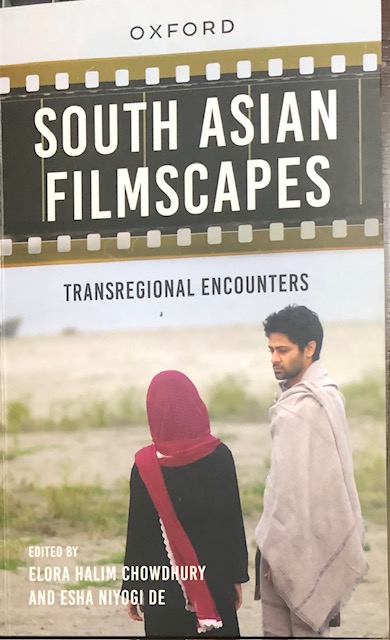South Asian Filmscapes
Syed Afsar Sajid
Title: ‘South Asian Filmscapes — Transregional Encounters’
Published by: Oxford University Press, Karachi
Edited by: Elora Halim Chowdhury — Esha Niyogi De
Pages: 302 — Price: Rs.1295/-
The book being reviewed here is the maiden publication by SARMSNet (the South Asian Regional Media Scholars Network), an alliance set up by Elora Halim Chowdhury and Esha Niyogi De, co-editors of this volume. The former is professor of women’s, gender, and sexuality studies at the University Of Massachusetts Boston (US), while the latter is a lecturer in English at UCLA (the University of California, US). It aims at ‘exploring cross-communal filmic-histories’ in reference to a bordered subcontinent.
As an anthology of essays, the book is intended to explore the diverse and dynamic film industries as well as film cultures of South Asia including India, Pakistan, and Bangladesh in detail while those of Sri Lanka and Nepal, in passing. It examines the socio-cultural and political contexts that shape and regulate the production, distribution, and consumption of films in the region.
The book comprises three parts, each containing five, six, and four essays respectively. Essays in Part I (titled ‘Nations and Regional Margins’) relate to independent film making in the context of national identity in Bangladesh (Hamidul Haq); a critique of two Pakistani films ’Saheli’ (1960), co-produced and directed by S.M. Yusuf, and ‘Neela Parbat’ (1969), produced and directed by Ahmad Bashir, within the framework of female friendship and forbidden desire (Kamran Asdar Ali); bringing back Sikhs into the mainstream of Indian cinema after the 1984 pogrom within the purview of the politics of picturization in Hindi cinema (Amit Ranjan); film making in the Chittagong Hill Tracts (CHT) and issues concerning the indigenous cinema’s challenge to the imagined cultural homogeneity of Bangladesh (Glen Hill and Kabita Chakma); and Pakistan’s ace auteur Hassan Tariq’s debut movie ‘Neend’ as a reflection of his aesthetic vision in the backdrop of ‘sleep’ as a trope implying ‘a gendered Pakistani national and moral subject’ (Nasreen Rehman).
Part II (titled ‘Transregional Crossings’) incorporates essays on a cinematic study of the Indian cities of Bombay, Calcutta and Lahore (1920s-1930s) (Madujha Mukherjee); ‘East Pakistani’ Urdu films and their traces on the Bangladesh film archive (Lotte Hoek); action heroines in film maker Shamim Ara’s movies (Cf. Miss Hong Kong, Miss Colombo, and Miss Singapore) (Esha Niyogi De); realism and region in South Indian cinemas, 1947-1977 (Hariprasad Athanickal); articulations of the diaspora in Pakistani Punjabi film with reference to two Punjabi movies titled ‘Pehlwanji in London’ and ‘Jatt in London’(Gwendolyn S. Kirk); and the birth of a Cinema in post-9/11 Pakistan (Zebunnisa Hamid).
Part III (captioned ‘Fractured Geographies, South Connectivities’) deals with titles like Zahir Raihan’s ‘Stop Genocide’ (1971): a dialectical cinematic message to the world (Fahmida Akhter); gender, war, and resistance: the case of Kashmir (Alka Kurian); the films of Alamgir Kabir fostering a vital critical consciousness (Naadir Junaid); and friendship and healing in contemporary films about the Bangladesh liberation movement (Elora Halim Chowdhury).
The essays are written by scholars and film-makers from South Asia and the diaspora, providing a wide range of perspectives on the subject. The book analyzes the modes and ways in which South Asian films engage with issues like gender, sexuality, belief, religion, nationalism, and globalization. It provides an insightful look at the glamorous but complex world of South Asian cinema.
One of the major strengths of the book is its ‘interdisciplinary approach’, drawing on film studies, cultural studies, and political science to formulate a comprehensive analysis of South Asian cinema. The essays contained in the book explore the characteristic features of each national cinema and the shared themes and concerns that integrate them despite their seeming diversity inter se.
Indian cinema, Bollywood, is the most popular form of South Asian cinema with its larger-than-life musical scores, melodramatic storylines, and star-studded casts. Simultaneously, the Indian film industry is also producing art movies which present a more ‘nuanced and realistic’ representation of Indian society.
Pakistan’s film industry, Lollywood, has of late experienced a resurgence with a growing number of films being launched and screened at international festivals, with their focus on social issues like gender discrimination, religious extremism, and corruption.
Bangladesh’s filmdom, Dhallywood, is gradually gaining reputation for its apt storytelling and visual style. Sri Lanka and Nepal also have their own film industries which though smaller in size, do produce a good number of high-quality films every year.
In conclusion, whereas cinematic art observers and critics have extended a superior rating to the book yet they have also questioned its ‘dense and academic’ style which might render it less accessible to common readers.
However, the counter argument advanced by a section of discreet readers of the book is that it is primarily meant for scholars and students of film and cultural studies, rather than a wider general audience.





















